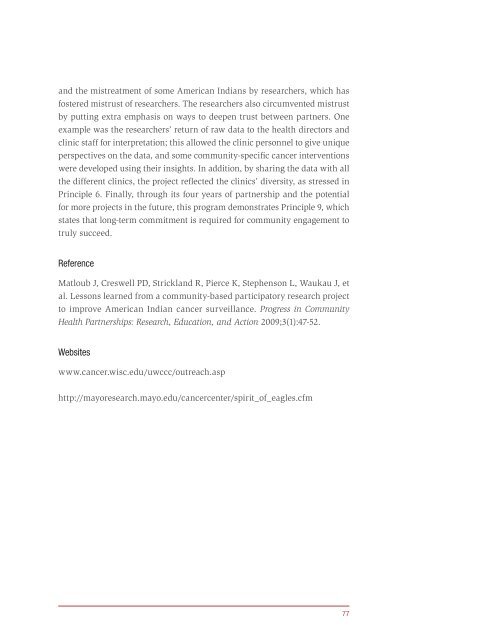Principles of Community Engagement (Second Edition)
Principles of Community Engagement (Second Edition)
Principles of Community Engagement (Second Edition)
You also want an ePaper? Increase the reach of your titles
YUMPU automatically turns print PDFs into web optimized ePapers that Google loves.
and the mistreatment <strong>of</strong> some American Indians by researchers, which has<br />
fostered mistrust <strong>of</strong> researchers The researchers also circumvented mistrust<br />
by putting extra emphasis on ways to deepen trust between partners One<br />
example was the researchers’ return <strong>of</strong> raw data to the health directors and<br />
clinic staff for interpretation; this allowed the clinic personnel to give unique<br />
perspectives on the data, and some community-specific cancer interventions<br />
were developed using their insights In addition, by sharing the data with all<br />
the different clinics, the project reflected the clinics’ diversity, as stressed in<br />
Principle 6 Finally, through its four years <strong>of</strong> partnership and the potential<br />
for more projects in the future, this program demonstrates Principle 9, which<br />
states that long-term commitment is required for community engagement to<br />
truly succeed<br />
Reference<br />
Matloub J, Creswell PD, Strickland R, Pierce K, Stephenson L, Waukau J, et<br />
al Lessons learned from a community-based participatory research project<br />
to improve American Indian cancer surveillance Progress in <strong>Community</strong><br />
Health Partnerships: Research, Education, and Action 2009;3(1):47-52<br />
Websites<br />
www cancer wisc edu/uwccc/outreach asp<br />
http://mayoresearch mayo edu/cancercenter/spirit_<strong>of</strong>_eagles cfm<br />
77

















